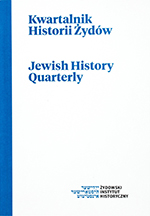Rudolf Höss w „Kraju Warty”: rzecz o nieznanej instytucji akcji „Reinhard” przy obozie zagłady Kulmhof
Rudolf Höss in “Reichsgau Wartheland”: an Unknown Facet of “Operation Reinhard” from Kulmhof Extermination Camp
Author(s): Jacek Andrzej MłynarczykSubject(s): History
Published by: Żydowski Instytut Historyczny
Keywords: “Sonderaktion 1005”; operation “Reinhard“; Kulmhof extermination camp; Auschwitz-Birkenau camp; Bełżec extermination camp; Sobibor extermination camp; Treblinka extermination camp; Holocaust
Summary/Abstract: In the summer of 1942, an important if hardly known to historians institution was added to the Kulmhof extermination camp in “Wartheland”; it was called “Reinhard Operation Field Furnace Experimental Station”. It was established by SS-Standartenführer Paul Blobel, whom the Reich Security Main Office (Reichssicherheitshauptamt) entrusted with carrying out a secret operation consisting in the elimination of mass graves located in the occupied Eastern Europe lands, so as to eliminate tangible evidence making it possible to determine the volume of the genocide of the civilian population perpetrated by the Germans. This task was code-named “1005”. The chief responsibility of the “Experimental Station” consisted in experimental devising of techniques that could be used for efficient and fast annihilation of corpses and removing of traces of mass graves left by the genocide program targeted on the Jewish population and effected in extermination camps. There is every indication that all the activities involving the aforementioned “Experimental station” was a prelude to “Sonderaktion 1005”, although this was top secret information. The experiments focused on the most efficient methods of getting rid of corpses from Kulmhof camp mass graves, and the experience gained there was also shared with “Reinhard Operation” extermination camps, which from the spring of 1942 were struggling with a number of problems ensuing from tens of thousands of bodies buried in too shallow graves, which took too long to decompose and posed a growing health risk to the personnel of these camps and the area inhabitants. Relying on the available source materials, the author seeks to determine the mechanisms leading to the establishment of this “Experimental station”, the scope of the experiments performed there and the manner of transferring the knowledge thus obtained to other extermination camps making up operation “Reinhard”. It also sheds fresh light on the early phase of “Sonderaktion 1005” commanded by Paul Blobel, who managed to use that institution to shift a material part of his accountability for the exhumations and the annihilation of the millions of Holocaust victims from Auschwitz-Birkenau, Bełżec, Sobibor and Treblinka death camps on their personnel, even though they were not his subordinates after all.
Journal: Kwartalnik Historii Żydów
- Issue Year: 286/2023
- Issue No: 02
- Page Range: 351-376
- Page Count: 26
- Language: Polish

